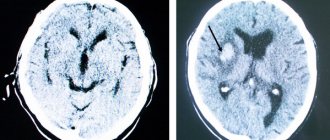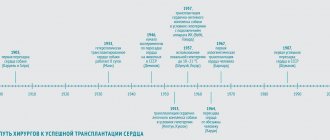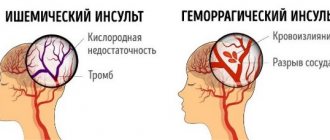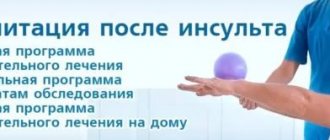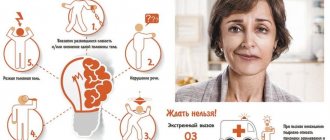A stroke is a sudden disruption in the circulatory system of the brain, which leads to damage to various parts of the brain that lose functionality.
Along with the blood, the supply of oxygen to the brain stops. This leads to disruption of cell nutrition.
The short answer to the question of how long people live after a stroke depends on the type of brain stroke, as well as how serious the consequences are - with ischemic, mortality in the first 72 hours is no more than 15%; for hemorrhagic – no more than 35%; the most dangerous is subarachnoid hemorrhage - survival rate in the first 72 hours is about 50%. Details are below.
Briefly about the main thing - features of ischemia and hemorrhage
There are two main types of stroke:
- Ischemic
. Leads to contraction of blood vessels in the head, which clogs their walls, causing hypoxia. - Hemorrhagic
. The process of bleeding into the brain, often fatal.
According to statistics, the ratio between the two species is 80% to 20% (Consilium Medicum No. 02 2000).
Ischemic stroke can develop at any age - in children, adolescents, middle-aged people and the elderly. The severity of the consequences is also individual, depending on the speed of decision-making after the attack, the correct diagnosis, and the prescribed treatment.
Hemorrhagic stroke can happen to a person of any age. It occurs suddenly and is accompanied by a serious condition of the patient, constant gag reflexes and severe headache. At the first signs, a person often loses consciousness.
Causes:
- sudden movements, change of position;
- food with a lot of fat and other harmful ingredients;
- bad habits - smoking, alcohol addiction, drug addiction;
- high water temperature during water procedures or outdoors;
- excessive physical or psychological load on the human body;
- cardiac arrhythmia;
- blood pressure problems.
Information about stroke - clickable
When the first symptoms of a stroke appear, you should be careful and prompt; minutes count. On average, 3-4 hours after the first signs appear, the condition of the blood vessels in the brain deteriorates, and the consequences may become irreversible. The first 3-4 hours are the most important in the fight against the disease.
If the signs and pain go away within 24 hours, the person most likely had a mini-stroke.
Symptoms of left-sided and right-sided strokes differ
Algorithm of actions when symptoms appear:
- Place the patient on a horizontal surface, holding his head at an angle of 30 degrees.
- If the victim feels sharp gag reflexes, you need to turn his head to the side.
- You should carefully monitor changes in blood pressure and pulse. It is recommended to measure them and monitor fluctuations.
- When emergency doctors appear, you should fully describe the picture of what happened. Tell what actions were taken before the doctors arrived.
Proper care for paralyzed patients
How to live after a stroke for a bedridden person? For many, paralysis becomes a death sentence, because in this state a person completely loses the ability to move and self-care. He needs the care of loved ones or a nurse.
Proper care for a person is the key to successful recovery
The person providing assistance must know a few simple rules:
- A bedridden patient should be turned over every 2 hours. This will help prevent bedsores and congestion in the lungs, leading to the development of pneumonia;
- The patient's skin should be wiped with an alcohol solution. This will prevent the development of bedsores and infection;
- the room needs to be ventilated regularly;
- if bedsores have already formed, the doctor should prescribe special medications in the form of ointments for their treatment;
- for fecal and urinary incontinence, diapers, diapers, and urinals are used;
- For patients in a coma, fluid is administered through a special tube. It should only be installed by a specialist.
In addition, the psychological aspect is important. If the paralyzed person is conscious, you need to talk to him and take an interest in his well-being. For such patients, it is necessary to understand that they are not alone and there are people who will always support them.
How long do they live after a stroke: statistics in detail
The life expectancy of a person after a stroke is highly individual. In 20% of cases, a person’s death occurs instantly.
Studies have shown that in the first 30 days the mortality rate is 30-40%; after the first year after a stroke, approximately 50% of patients die.
The repeated process of cerebral circulatory disturbance increases the possibility of death. Often, if a patient has a first stroke, he can live up to 10 years, but with a second attack on the brain, life expectancy is no more than 3 years.
The reason for such a high mortality rate after a second stroke is that after the first attack, lesions remain in the brain.
Dependence on age and gender
With hemorrhage before 40 years of age, the death rate is 15%, after 50 years of age – 45% of cases.
Women have a higher mortality rate than men – 39% versus 29%.
It is several times more difficult for newborns and people aged 65 years and above to survive a stroke. This is due to age-related factors in blood vessels and their walls, which cannot recover quickly. In newborns, the cells have not yet formed. Such wall problems lead to:
- inflammation of the cranial nerves;
- damage to the vascular system;
- hemorrhage.
Lesion size
This is the main aspect that affects how long a person can live after a stroke. Tissues susceptible to necrosis take a long time to recover.
The larger the affected area, the worse the prognosis.
How consequences affect the outcome
If after a stroke the patient begins to develop concomitant pathologies (paralysis, numbness or impaired psychological functions), then life expectancy decreases several times.
In addition, these consequences create the preconditions for the occurrence of bedsores. Bedsores form irreparable processes in the blood circulation of the whole body. Mental disorders require round-the-clock care for the patient, since he is not able to soberly assess the situation and take medications on time.
Life expectancy without movement
A person who is immobilized after an attack does not have the necessary desire for long-term recovery. Because of this psychological feature, a person does not strive to adhere to all norms and procedures, which is why muscle endurance decreases, fibers lose tone, and blood flow in the limbs is disrupted.
This ultimately leads to blood clots and tissue necrosis, which poison the blood.
Treatment, prevention, rehabilitation
It is very important to have time to provide assistance to a patient during a stroke in the first six hours from the onset of the attack. At the initial stage, problems associated with impaired respiratory and cardiac function are eliminated.
It is necessary to normalize blood circulation in the brain, stabilize the acid and electrolyte composition of the blood. To do this, the patient must be given special medications: for ischemic stroke, Actalyse is used, the drug actively counteracts the formation of blood clots in the blood vessels and restores normal blood flow. During the treatment of ischemic stroke, medications such as Heparin and Fragmin are prescribed, which prevent the formation of blockages and blood clots in the circulatory system, Cardiomagnyl, a blood thinner, Trental or Sermion as a vasoactive agent, Glycine , "Tiklid", some antioxidants and others.
What preventive measures should each person take to prevent a stroke? It turns out that protecting yourself from this disease is very easy. It is necessary to get rid of bad habits: quit smoking, give up drugs and alcohol, lead a healthy lifestyle, avoid stressful situations.
It should be remembered that curing a stroke quickly and without consequences is an extremely difficult task, but it can be done. Modern medicine uses all kinds of means for this: drug treatment, physiotherapy, occupational therapy, speech therapy and many others.
How to prolong and improve life after an ischemic stroke
The period after an ischemic attack is divided into five periods:
- The critical stage is the first 72 hours.
- Acute period – 25-30 days.
- The first stage of recovery is from 3 to 6 months.
- The second recovery period is 12–24 months.
- Residual processes – From 24 months or more.
Life expectancy after an ischemic stroke depends on numerous factors, from the size of the brain lesion to treatment measures. Providing first aid also affects the outcome of recovery; a simple rule applies here: the sooner, the better.
In the first year after ischemic hemorrhage, 65% of patients survive, after 5 years half survive, but after 10 years only a quarter remain alive.
Help to prolong life:
- correct lifestyle;
- diagnostics every 2 – 3 months;
- nutrition;
- restorative gymnastics.
Salt, sugar, fatty and flour foods, smoked meats and sauces should be excluded from the diet. The diet should be dominated by vegetables and fruits, a large amount of fiber and vegetarian soups. Meals should be fractional, 5 meals in small portions.
Timely diagnosis and physical therapy, which improves the quality of blood flow, will help prevent a recurrent attack.
Healing Fitness
In addition to caring for the person and proper nutrition, many patients are prescribed special physical exercises. Physical education helps to quickly tone muscles and restore the ability to self-care.
The first exercises are for the patient to learn to sit independently, then lower his legs from the bed, and walk. These simple elements are given to most patients with great difficulty. Later, the load gradually increases. The patient performs exercises designed to work different muscle groups. Bending, swinging your arms, turning your head - all these elements help restore normal motor activity and prevent stagnation.
In rehabilitation centers, the following types of treatment are used to restore a person:
- mirror therapy;
- modeling;
- drawing;
- collecting puzzles.
Therapy based on biofeedback has good results. This method involves controlling the affected arm or leg using your imagination. This is believed to help revitalize areas of the brain damaged during a stroke.
Massage
After normalization of the patient’s vital functions, massage can be used. Typically this period takes from 5 to 7 days. After this, it is recommended to turn the patient over and gently rub the skin of the back and sacrum. A full massage is carried out after 1–1.5 months.
An integral part of rehabilitation is massage.
Like other types of treatment, massage should be done in doses. Up to three sessions of 3–5 minutes each can be performed per day. The specialist performs the procedure using the following technique:
- stroking the skin with transverse or circular movements;
- rubbing fingers;
- tapping with a fist or the edge of the palm over the entire massaged surface;
- vibrating movements, pinching;
- at the end of the procedure - stroking.
Such actions help prevent muscle tissue atrophy, improve blood circulation, and prevent bedsores.
Important! The procedure should only be performed by a specialist. Unprofessional actions can only do harm.

